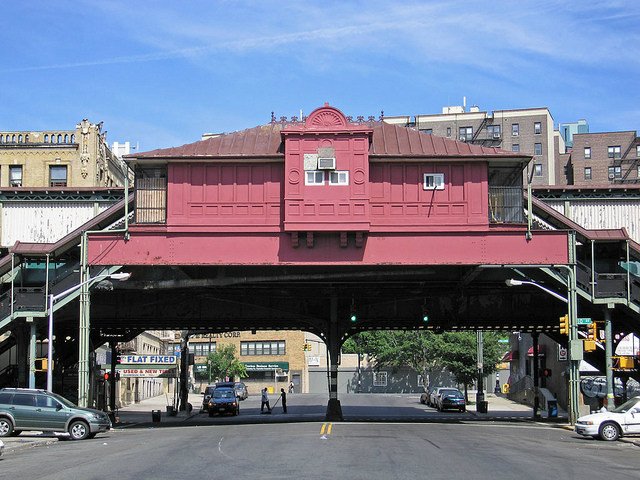Inwood Residents & Small Business Owners Fear Rezoning Plan Will Open Gentrification Floodgates
July 10, 2018, 11:45 a.m.
Inwood residents and small business owners fear this push to create affordable housing might ironically destroy it.

215th Street Station in Inwood.
Upper Manhattan community organizers say a proposal to rezone Inwood and create more housing will lead to the decimation of mom-and-pop businesses along the neighborhood’s primary commercial corridor.
“This rezoning would push out almost every single existing small business in Inwood. And that sounds quite dramatic — and unfortunately, the situation is quite dramatic.” said Karla Fisk, with the Inwood Small Business Coalition. “It’s quite dire.”
Fisk said that based on numbers from the Manhattan Borough President’s Office, the rezoning could lead landlords to push out more than 150 independent family businesses, most of them owned by immigrants. The landlords would then redevelop the land for high rises and big box stores.
The plan is part of Mayor Bill de Blasio’s push to rezone 15 neighborhoods in the city to create greater housing density and more affordable housing. But many locals, who describe Inwood as a walkable, family-friendly neighborhood, say the plan would ruin its character, creating luxury towers along the commercial corridor and the waterfront and encouraging the displacement of local residents and businesses.
“It’s a shame what they’re going to do, it’s a crime,” said Bill Levy, who with his wife has owned Plum, a discount women’s clothing store on Dyckman Street, for 25 years. He expects that his own store will be forced to close — but he’s also worried about his neighbors. “There’s a Korean-owned, little store next to me... it’s been there close to 40 years. It’s going to be put out of business. Down the block there’s an old fashioned hardware store — these are stores that every neighborhood needs.”
Manhattan Borough President Gale Brewer has come out against the plan; her office estimates that it might lead to the loss of up to 800 jobs.
Last night community came out for prayer vigil on the #InwoodRezoning Please think of these people, those unable to testify today and those that left family and jobs with no pay to attend today. The Inwood Community overwhelmingly OPPOSES the EDC rezoning plan. @NYCSpeakerCoJo pic.twitter.com/pvRDVbopkH
— Nancy Preston (@nancypontz) July 10, 2018
Organizers are also concerned that this push to create affordable housing might ironically destroy it. Inwood’s median income is about $42,000, and 60 percent of its housing is rent-regulated. A map last year from ProPublica found it has some of the highest percentages of rent-stabilized apartments with preferential rents. Those rents are lower than the allowable rent, which means that many tenants are vulnerable to a huge jump in their rent upon lease renewal.
Some have also pointed out that there’s no new police precinct or schools for the expected influx of residents, and the waterfront access will be a thin, 20-to-40-foot promenade along the river.
Yet the zoning plan, which has been in the works since 2015, is likely to go forward despite vocal and sustained community opposition. It is designed to spur residential and commercial development in a sizable chunk of the neighborhood that’s currently zoned for industrial or automotive uses. Last month, it passed the city’s planning commission. The last public hearing is today, and it is generally expected that the City Council will vote in favor of it by the end of August.
Not every resident thinks that’s a bad thing. Brendan MacWade, who’s lived in Inwood since 2006, said that he’s happy the more industrial sections of the neighborhood will be converted to residential and commercial use. “A selfish part of me wants Inwood to be more like Manhattan rather than The Bronx or the eastern half of Long Island City,” he wrote in an email. “I think there should be more affordable apartments rather than auto body shops. used car lots and gas stations.” He noted that, even without a rezoning, the neighborhood has been changing with an influx of “aging hipsters from Brooklyn.”
And Councilmember Ydanis Rodriguez, who represents Inwood and has been spearheading the upzoning, says the plan will create new opportunities for the neighborhood and will allow more access to the Harlem River waterfront. The city estimates it will add about 4,300 units of housing, about one-quarter of those affordable. Rodriguez has said that “keeping our families in our homes” and protecting small businesses and are both priorities of his, and in a press release, he highlighted programs like an increase in funding for legal services organizations that help tenants fight landlord harassment, and the Small Business Investment Fund “to stimulate business growth."
But community organizers remain unconvinced. Nova Lucero has been organizing against the plan on behalf of the tenant’s rights organization Metropolitan Council on Housing and she said the upzoning of the industrial district to a commercial one could have effects beyond just the displacement — and perhaps disappearance — of the current businesses. For example, the wholesale stores in the industrial district are a main supplier for the bodegas in Upper Manhattan and the Bronx. The auto-supply and repair businesses keep the local black cars and taxis humming. What’s going to happen to all those people and all those jobs, she asks.
“It’s not just about the flashy and beautiful,” she said. “A couple of towers along the Harlem River looks really good, and you might have a beautiful promenade... but if the people are no longer there, you can’t really call it a success.”
Listen to WNYC's Jennifer Vanasco on neighborhood opposition to the Inwood Rezoning plan: